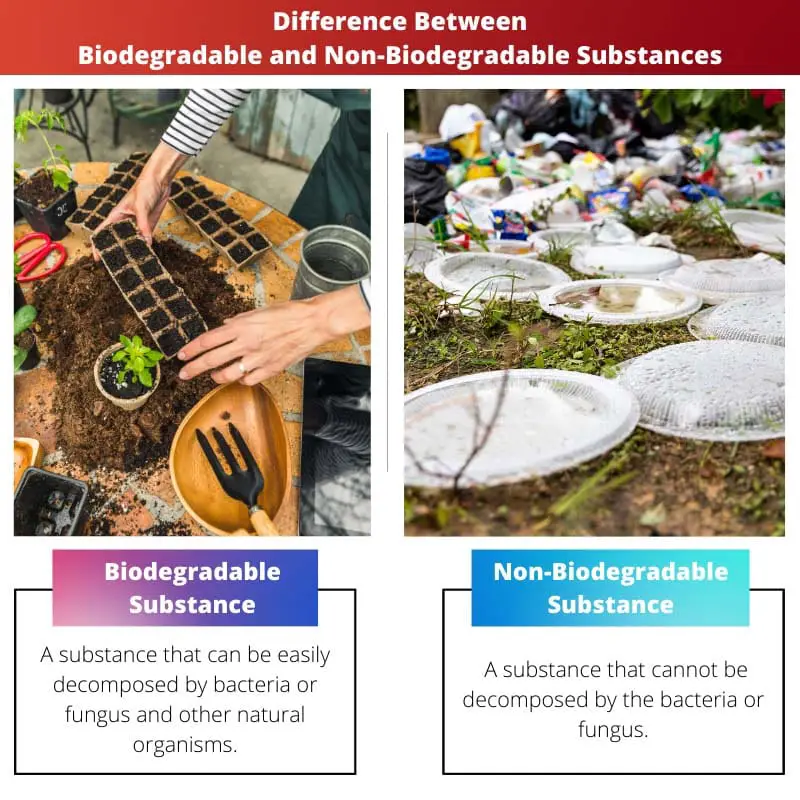Biodegradable substances can be naturally broken down and decomposed into environmentally friendly components by biological processes. In contrast, non-biodegradable substances do not easily decompose and can persist in the environment for extended periods, potentially causing pollution and harm.
Key Takeaways
- Biodegradable substances can be broken down into simpler substances by microorganisms.
- Non-biodegradable substances cannot be broken down by natural processes and persist in the environment for a long time.
- Biodegradable substances are less harmful to the environment than non-biodegradable substances.
Biodegradable vs Non-Biodegradable Substances
Biodegradable wastes are those which get decomposed or dissolved by natural gases, for instance, fruits, paper, vegetables, plants, animals, etc. Non-biodegradable substances are those which don’t get decomposed by natural gases, for instance, rubber, paint, chemicals or plastic.

Comparison Table
| Feature | Biodegradable Substances | Non-Biodegradable Substances |
|---|---|---|
| Definition | Substances that can be decomposed by naturally occurring organisms like bacteria, fungi, and worms | Substances that cannot be decomposed by naturally occurring organisms |
| Decomposition time | Relatively short, ranging from days to months | Very long, ranging from years to thousands of years |
| Impact on environment | Have a minimal impact on the environment as they are decomposed and recycled back into the ecosystem | Can have a significant negative impact on the environment as they accumulate and pollute land, water, and air |
| Examples | Food scraps, paper, wood, leaves, human waste | Plastic, glass, metal, rubber, chemicals |
| Benefits | Reduce waste by decomposing and returning nutrients to the soil | Strong and durable, have longer lifespan |
| Drawbacks | Attract pests and animals | Can harm wildlife if ingested |
| Disposal methods | Composting, recycling, landfilling | Recycling, landfilling (with special precautions) |
What are Biodegradable Substances?
Biodegradable substances are organic materials that can be decomposed by naturally occurring organisms like bacteria, fungi, and worms. These substances decompose relatively quickly, within days or months, and are broken down into simple organic molecules that plants can absorb and reuse in the ecosystem.
Key characteristics of biodegradable substances:
- Organic origin: They are derived from living organisms such as plants, animals, and microorganisms.
- Porous structure: Their structure allows bacteria and other decomposers to access the organic matter and break it down.
- Susceptible to decomposition: They readily react with natural enzymes and microorganisms, leading to their breakdown.
- Environmentally friendly: After decomposing, they release nutrients into the soil, enriching the environment and contributing to plant growth.
- Wide range of examples: Biodegradable substances include food scraps, paper, wood, leaves, grass, animal waste, and even human waste.
Benefits of using biodegradable substances:
- Reduced impact on landfills: They decompose instead of accumulating in landfills, saving valuable space and minimizing environmental pollution.
- Improved soil health: By releasing nutrients back into the soil, they contribute to soil fertility and plant growth.
- Sustainable resource utilization: They represent a more sustainable alternative to non-biodegradable materials, minimizing dependence on finite resources.
- Reduced greenhouse gas emissions: Their decomposition process generates less harmful greenhouse gases compared to the burning or decomposition of non-biodegradable materials.
- Promotes biodiversity: They contribute to a healthy ecosystem by supporting the growth of various organisms involved in the decomposition process.
Examples of biodegradable substances:
- Food scraps: fruits, vegetables, eggshells, tea bags
- Paper products: cardboard, tissues, paper towels
- Yard waste: leaves, grass clippings, twigs
- Natural fibers: cotton, wool, linen
- Wood and wood products
- Animal waste: manure, compost
- Human waste: treated sewage

What are Non-Biodegradable Substances?
Non-biodegradable substances resist decomposition by naturally occurring organisms like bacteria, fungi, and worms. Unlike their biodegradable counterparts, they remain relatively unchanged for years, decades, or even centuries, posing a significant environmental threat when improperly managed.
Key characteristics of non-biodegradable substances:
- Synthetic origin: They are made from man-made materials like plastics, metals, glass, and chemicals, which lack the organic components necessary for natural decomposition.
- Non-porous structure: Their tight structure prevents enzymes and decomposers from accessing the material and initiating the breakdown process.
- Resistant to decay: They remain intact for extended periods, accumulating in landfills and causing environmental pollution.
- Harmful environmental impact: Their presence can harm wildlife through ingestion, disrupt natural habitats, and contribute to land, air, and water pollution.
- Examples: Plastic bags, bottles, utensils, packaging materials, glass bottles, metal cans, tires, synthetic fabrics, electronics, chemicals, and batteries.
Negative impacts of non-biodegradable substances:
- Landfill accumulation: They fill up landfills rapidly, leading to land scarcity and depletion.
- Wildlife endangerment: Animals can mistake them for food, leading to choking, internal blockages, and even death.
- Habitat destruction: Landfills and plastic pollution can destroy natural habitats and disrupt ecosystems.
- Water pollution: Microplastics from non-biodegradable materials can enter waterways, harm aquatic life, and contaminate our water.
- Air pollution: Burning non-biodegradable materials releases harmful toxins and greenhouse gases into the atmosphere, contributing to air pollution and climate change.
Alternatives to non-biodegradable substances:
- Biodegradable options: Opt for items made from sustainable materials like bamboo, wood, or recycled paper.
- Reusable products: Use alternatives like cloth bags, water bottles, and food containers.
- Proper disposal: Dispose of non-biodegradable waste responsibly through recycling programs and designated facilities.
- Reduce consumption: Minimize reliance on single-use items and choose products with minimal packaging.
- Support sustainable businesses: Choose companies committed to using sustainable materials and responsible production practices.

Main Differences Between Biodegradable and Non-Biodegradable Substances
- Decomposition:
- Biodegradable Substances: Biodegradable substances can be broken down and decomposed by natural biological processes, such as the activity of microorganisms, into simpler, environmentally friendly components. This decomposition occurs relatively quickly.
- Non-Biodegradable Substances: Non-biodegradable substances do not easily decompose through natural biological processes. They persist in the environment for extended periods, causing pollution and accumulating in ecosystems.
- Environmental Impact:
- Biodegradable Substances: Biodegradable materials have a lower environmental impact because they can be naturally recycled and reintegrated into the ecosystem without causing long-term harm.
- Non-Biodegradable Substances: Non-biodegradable materials can have a significant environmental impact, as they accumulate in landfills, oceans, and natural habitats, contributing to pollution and environmental degradation.
- Examples:
- Biodegradable Substances: Examples of biodegradable materials include organic matter like food waste, paper, cardboard, and some plastics designed to biodegrade. These materials can be composted or broken down in the environment.
- Non-Biodegradable Substances: Examples of non-biodegradable materials include many synthetic plastics, certain chemicals, and heavy metals. These materials do not readily break down and can persist for centuries.
- Waste Management:
- Biodegradable Substances: Managing biodegradable waste involves composting or other natural decomposition methods, which can reduce the need for landfill disposal and decrease the environmental impact.
- Non-Biodegradable Substances: Non-biodegradable waste requires specialized disposal methods, such as recycling or incineration, to minimize its environmental impact and prevent it from accumulating in the environment.
- Resource Conservation:
- Biodegradable Substances: Biodegradable materials are derived from renewable resources, such as plants, and contribute to resource conservation and sustainability.
- Non-Biodegradable Substances: Non-biodegradable materials may be derived from non-renewable resources, and their production can have a higher environmental footprint.


The alternative recommendations for reducing non-biodegradable waste provide actionable steps for individuals to contribute to environmental preservation. This article promotes a proactive approach to minimizing ecological harm through informed decision-making.
The comprehensive list of examples for both biodegradable and non-biodegradable substances enhances the practical relevance of this article. It equips readers with tangible examples that illustrate the concepts discussed, making it a valuable educational tool.
The thorough examination of the characteristics of biodegradable and non-biodegradable substances enriches our understanding of their ecological impact. The article effectively addresses both the scientific and practical dimensions of the topic.
The negative impacts of non-biodegradable substances on the environment, including wildlife endangerment and air pollution, serve as a stark reminder of the urgency to transition towards sustainable alternatives. This piece powerfully illustrates the need for responsible consumption and waste management.
The benefits of using biodegradable substances, such as reduced impact on landfills and improved soil health, are compelling arguments for incorporating them into daily practices. This article effectively highlights the positive implications of biodegradability.
The thorough coverage of decomposition, negative impacts, and sustainable alternatives underscores the urgency of transitioning towards biodegradable materials. It serves as a compelling call-to-action for embracing sustainable practices.
The emphasis on the sustainable utilization of biodegradable substances and their positive contributions to biodiversity aligns with the global shift towards environmentally conscious practices. This article reinforces the importance of considering ecological implications in material choices.
This article offers a comprehensive overview of the differences between biodegradable and non-biodegradable substances, shedding light on their environmental impact and decomposition processes. It is a well-researched and informative read for anyone interested in sustainable living.
The clear articulation of the main differences between biodegradable and non-biodegradable substances fosters a deeper awareness of their distinct characteristics. This article effectively demystifies the subject matter, rendering it accessible to a wide audience.
The comparison table and detailed descriptions provide a clear understanding of the distinction between biodegradable and non-biodegradable substances. It’s a valuable resource for individuals and organizations aiming to make eco-friendly choices.